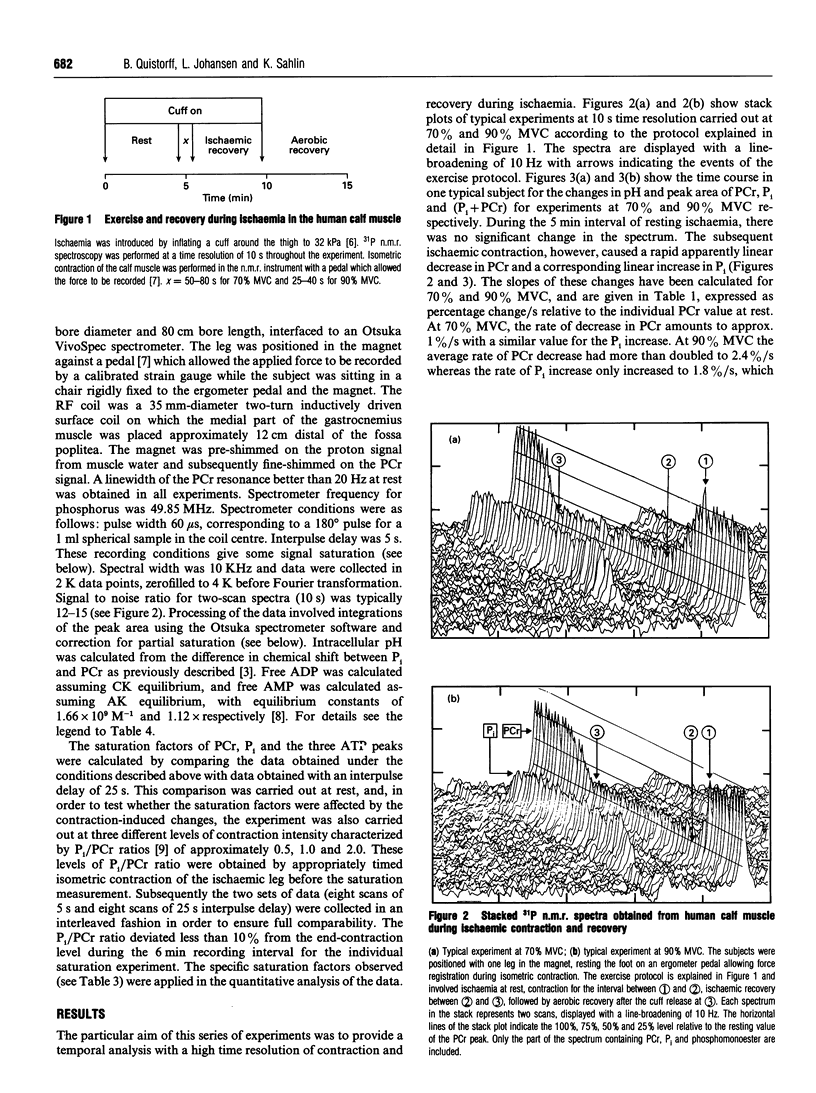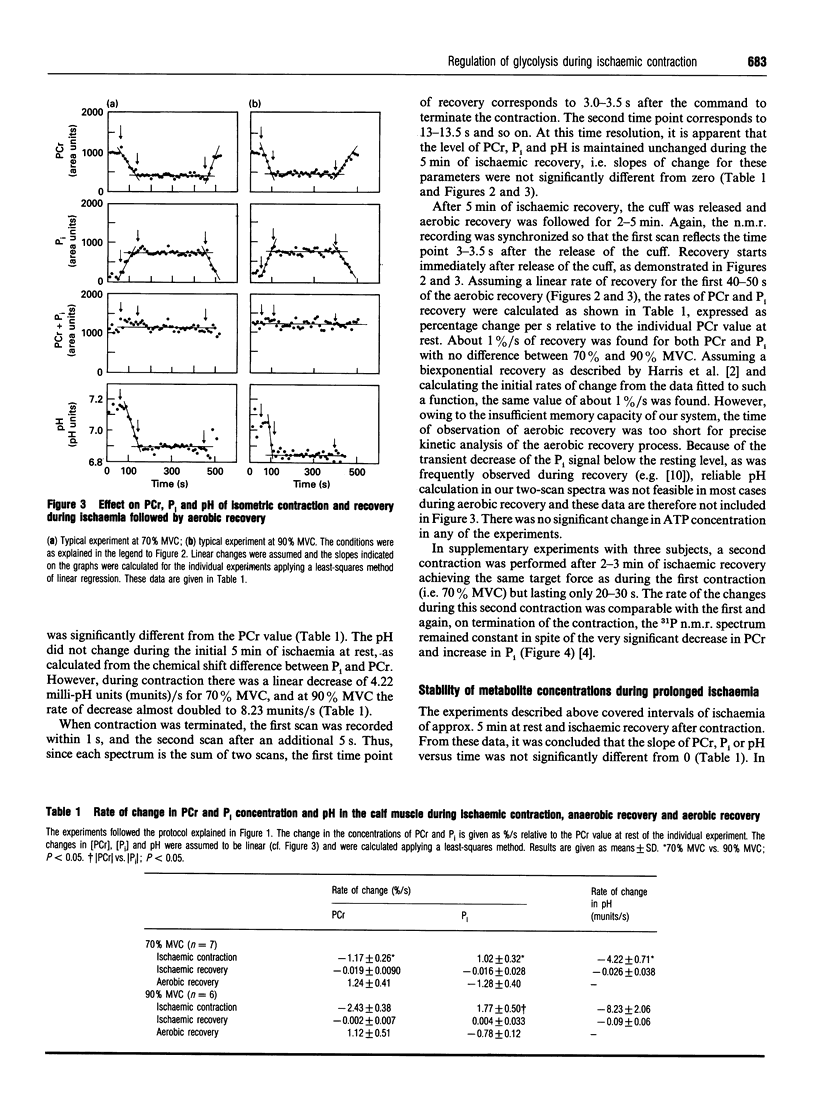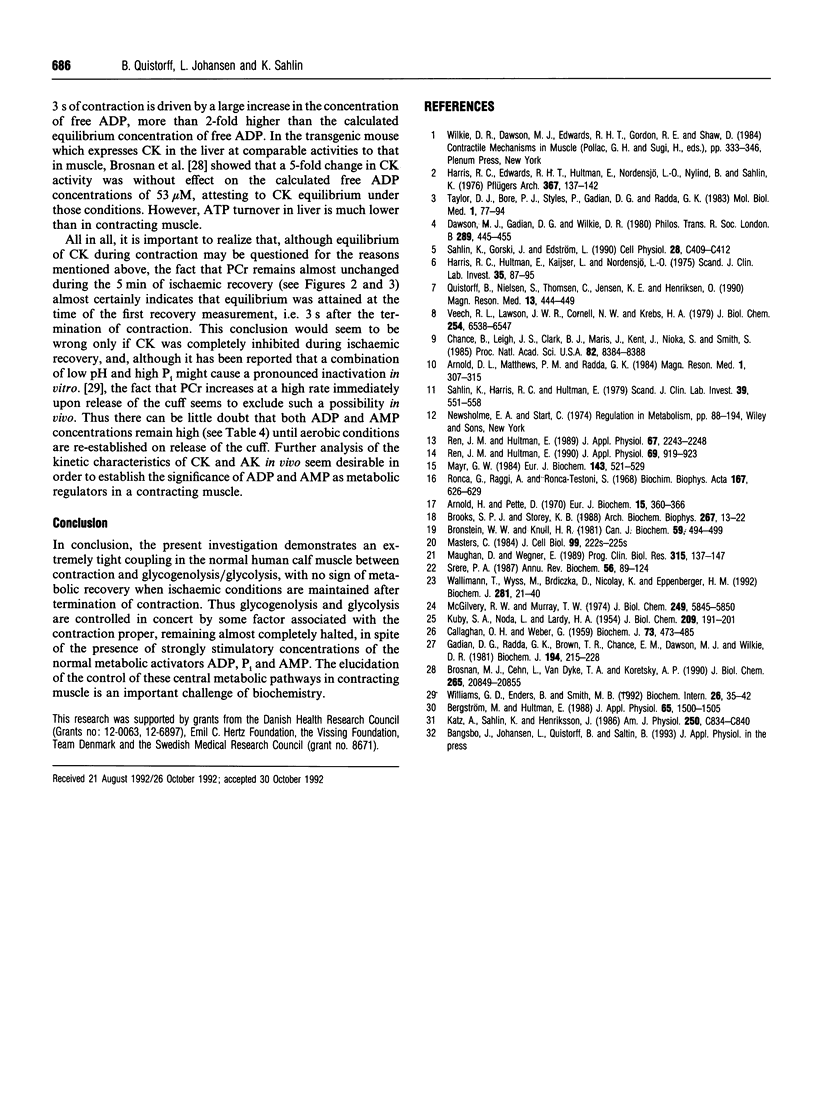Abstract
Changes in the metabolites phosphocreatine (PCr), Pi and ATP were quantified by 31P n.m.r. spectroscopy in the human calf muscle during isometric contraction and recovery under ischaemic conditions. Time resolution of the measurements was 10 s. During a 30-60 s ischaemic isometric contraction, PCr decreased linearly at a rate of 1.17%/s (relative to the resting value) at a contraction strength equivalent to 70% of the maximal voluntary contraction (MVC) and at a rate of 2.43%/s at 90% MVC. There was a corresponding increase in Pi but the concentration of ATP did not change. pH decreased linearly during contraction by 4.22 and 8.23 milli-pH units/s at 70 and 90% MVC respectively. During a subsequent 5 min interval of ischaemic recovery, PCr, Pi, ATP, phosphomonoesters and calculated free ADP, free AMP and pH retained the value they had attained by the end of contraction with no significant recovery. Thus it is concluded that anaerobic glycolysis and glycogenolysis is halted momentarily on termination of contraction and that PCr is not resynthesized during ischaemic recovery. This paradoxical arrest of glycolytic flow in spite of the very significantly elevated concentration of potent activators such as Pi and free AMP clearly indicates that parameters other than PCr, ATP, Pi, calculated pH, free ADP and free AMP regulate glycolysis and glycogenolysis of human skeletal muscle very efficiently under ischaemic conditions.
Full text
PDF





Selected References
These references are in PubMed. This may not be the complete list of references from this article.
- Arnold D. L., Matthews P. M., Radda G. K. Metabolic recovery after exercise and the assessment of mitochondrial function in vivo in human skeletal muscle by means of 31P NMR. Magn Reson Med. 1984 Sep;1(3):307–315. doi: 10.1002/mrm.1910010303. [DOI] [PubMed] [Google Scholar]
- Arnold H., Pette D. Binding of aldolase and triosephosphate dehydrogenase to F-actin and modification of catalytic properties of aldolase. Eur J Biochem. 1970 Aug;15(2):360–366. doi: 10.1111/j.1432-1033.1970.tb01016.x. [DOI] [PubMed] [Google Scholar]
- Bergström M., Hultman E. Energy cost and fatigue during intermittent electrical stimulation of human skeletal muscle. J Appl Physiol (1985) 1988 Oct;65(4):1500–1505. doi: 10.1152/jappl.1988.65.4.1500. [DOI] [PubMed] [Google Scholar]
- Bronstein W. W., Knull H. R. Interaction of muscle glycolytic enzymes with thin filament proteins. Can J Biochem. 1981 Jul;59(7):494–499. doi: 10.1139/o81-069. [DOI] [PubMed] [Google Scholar]
- Brooks S. P., Storey K. B. Reevaluation of the "glycolytic complex" in muscle: a multitechnique approach using trout white muscle. Arch Biochem Biophys. 1988 Nov 15;267(1):13–22. doi: 10.1016/0003-9861(88)90002-1. [DOI] [PubMed] [Google Scholar]
- Brosnan M. J., Chen L., Van Dyke T. A., Koretsky A. P. Free ADP levels in transgenic mouse liver expressing creatine kinase. Effects of enzyme activity, phosphagen type, and substrate concentration. J Biol Chem. 1990 Dec 5;265(34):20849–20855. [PubMed] [Google Scholar]
- CALLAGHAN O. H., WEBER G. Kinetic studies on rabbitmuscle myokinase. Biochem J. 1959 Nov;73:473–485. doi: 10.1042/bj0730473. [DOI] [PMC free article] [PubMed] [Google Scholar]
- Chance B., Leigh J. S., Jr, Clark B. J., Maris J., Kent J., Nioka S., Smith D. Control of oxidative metabolism and oxygen delivery in human skeletal muscle: a steady-state analysis of the work/energy cost transfer function. Proc Natl Acad Sci U S A. 1985 Dec;82(24):8384–8388. doi: 10.1073/pnas.82.24.8384. [DOI] [PMC free article] [PubMed] [Google Scholar]
- Dawson M. J., Gadian D. G., Wilkie D. R. Studies of the biochemistry of contracting and relaxing muscle by the use of 31P n.m.r. in conjunction with other techniques. Philos Trans R Soc Lond B Biol Sci. 1980 Jun 25;289(1037):445–455. doi: 10.1098/rstb.1980.0062. [DOI] [PubMed] [Google Scholar]
- Gadian D. G., Radda G. K., Brown T. R., Chance E. M., Dawson M. J., Wilkie D. R. The activity of creatine kinase in frog skeletal muscle studied by saturation-transfer nuclear magnetic resonance. Biochem J. 1981 Jan 15;194(1):215–228. doi: 10.1042/bj1940215. [DOI] [PMC free article] [PubMed] [Google Scholar]
- Harris R. C., Edwards R. H., Hultman E., Nordesjö L. O., Nylind B., Sahlin K. The time course of phosphorylcreatine resynthesis during recovery of the quadriceps muscle in man. Pflugers Arch. 1976 Dec 28;367(2):137–142. doi: 10.1007/BF00585149. [DOI] [PubMed] [Google Scholar]
- Harris R. C., Hultman E., Kaijser L., Nordesjö L. O. The effect of circulatory occlusion on isometric exercise capacity and energy metabolism of the quadriceps muscle in man. Scand J Clin Lab Invest. 1975 Jan;35(1):87–95. [PubMed] [Google Scholar]
- KUBY S. A., NODA L., LARDY H. A. Adenosinetriphosphate-creatine transphosphorylase. I. Isolation of the crystalline enzyme from rabbit muscle. J Biol Chem. 1954 Jul;209(1):191–201. [PubMed] [Google Scholar]
- Katz A., Sahlin K., Henriksson J. Muscle ammonia metabolism during isometric contraction in humans. Am J Physiol. 1986 Jun;250(6 Pt 1):C834–C840. doi: 10.1152/ajpcell.1986.250.6.C834. [DOI] [PubMed] [Google Scholar]
- Masters C. Interactions between glycolytic enzymes and components of the cytomatrix. J Cell Biol. 1984 Jul;99(1 Pt 2):222s–225s. doi: 10.1083/jcb.99.1.222s. [DOI] [PMC free article] [PubMed] [Google Scholar]
- Maughan D., Wegner E. On the organization and diffusion of glycolytic enzymes in skeletal muscle. Prog Clin Biol Res. 1989;315:137–147. [PubMed] [Google Scholar]
- Mayr G. W. Interaction of calmodulin with muscle phosphofructokinase. Interplay with metabolic effectors of the enzyme under physiological conditions. Eur J Biochem. 1984 Sep 17;143(3):521–529. doi: 10.1111/j.1432-1033.1984.tb08401.x. [DOI] [PubMed] [Google Scholar]
- McGilvery R. W., Murray T. W. Calculated equilibria of phosphocreatine and adenosine phosphates during utilization of high energy phosphate by muscle. J Biol Chem. 1974 Sep 25;249(18):5845–5850. [PubMed] [Google Scholar]
- Quistorff B., Nielsen S., Thomsen C., Jensen K. E., Henriksen O. A simple calf muscle ergometer for use in a standard whole-body MR scanner. Magn Reson Med. 1990 Mar;13(3):444–449. doi: 10.1002/mrm.1910130311. [DOI] [PubMed] [Google Scholar]
- Ren J. M., Hultman E. Regulation of glycogenolysis in human skeletal muscle. J Appl Physiol (1985) 1989 Dec;67(6):2243–2248. doi: 10.1152/jappl.1989.67.6.2243. [DOI] [PubMed] [Google Scholar]
- Ren J. M., Hultman E. Regulation of phosphorylase a activity in human skeletal muscle. J Appl Physiol (1985) 1990 Sep;69(3):919–923. doi: 10.1152/jappl.1990.69.3.919. [DOI] [PubMed] [Google Scholar]
- Ronca G., Raggi A., Ronca-Testoni S. Muscle AMP aminohydrolase. I. Some regulatory properties of rat skeletal muscle enzyme. Biochim Biophys Acta. 1968 Nov 19;167(3):626–629. doi: 10.1016/0005-2744(68)90058-2. [DOI] [PubMed] [Google Scholar]
- Sahlin K., Gorski J., Edström L. Influence of ATP turnover and metabolite changes on IMP formation and glycolysis in rat skeletal muscle. Am J Physiol. 1990 Sep;259(3 Pt 1):C409–C412. doi: 10.1152/ajpcell.1990.259.3.C409. [DOI] [PubMed] [Google Scholar]
- Sahlin K., Harris R. C., Hultman E. Resynthesis of creatine phosphate in human muscle after exercise in relation to intramuscular pH and availability of oxygen. Scand J Clin Lab Invest. 1979 Oct;39(6):551–558. doi: 10.3109/00365517909108833. [DOI] [PubMed] [Google Scholar]
- Srere P. A. Complexes of sequential metabolic enzymes. Annu Rev Biochem. 1987;56:89–124. doi: 10.1146/annurev.bi.56.070187.000513. [DOI] [PubMed] [Google Scholar]
- Taylor D. J., Bore P. J., Styles P., Gadian D. G., Radda G. K. Bioenergetics of intact human muscle. A 31P nuclear magnetic resonance study. Mol Biol Med. 1983 Jul;1(1):77–94. [PubMed] [Google Scholar]
- Veech R. L., Lawson J. W., Cornell N. W., Krebs H. A. Cytosolic phosphorylation potential. J Biol Chem. 1979 Jul 25;254(14):6538–6547. [PubMed] [Google Scholar]
- Wallimann T., Wyss M., Brdiczka D., Nicolay K., Eppenberger H. M. Intracellular compartmentation, structure and function of creatine kinase isoenzymes in tissues with high and fluctuating energy demands: the 'phosphocreatine circuit' for cellular energy homeostasis. Biochem J. 1992 Jan 1;281(Pt 1):21–40. doi: 10.1042/bj2810021. [DOI] [PMC free article] [PubMed] [Google Scholar]
- Wilkie D. R., Dawson M. J., Edwards R. H., Gordon R. E., Shaw D. 31P NMR studies of resting muscle in normal human subjects. Adv Exp Med Biol. 1984;170:333–347. doi: 10.1007/978-1-4684-4703-3_28. [DOI] [PubMed] [Google Scholar]


